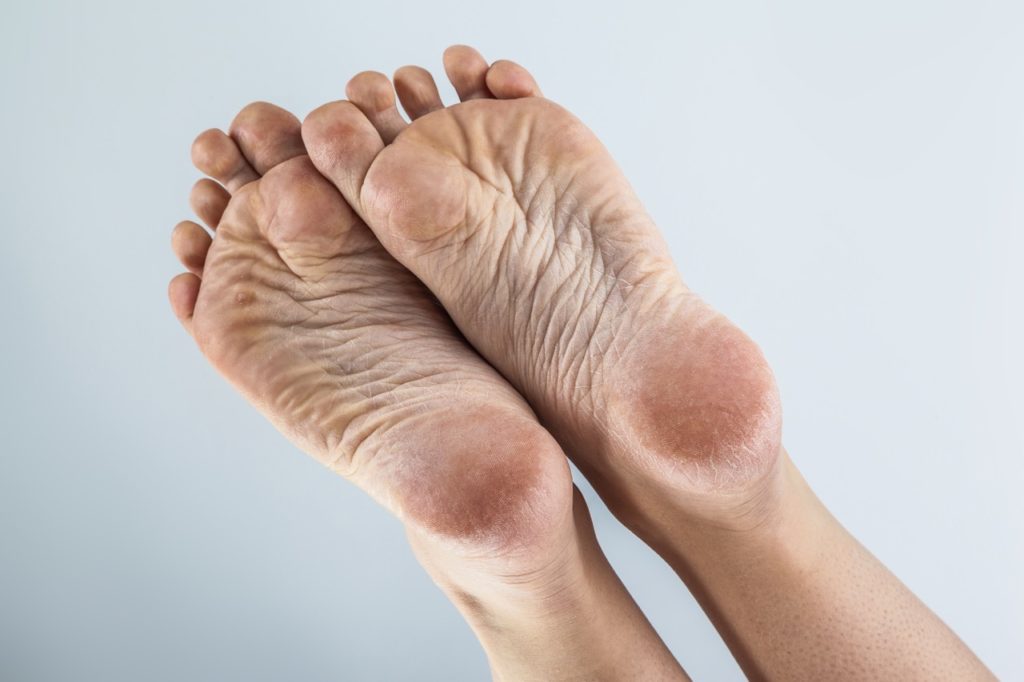What are cracked heels?
Definition and description
Callus or thick hard skin often forms on the feet, heels and areas of high localised pressure. Skin is a protective, delicate covering all over the body. Because external forces such as pressure exist, the skin protects itself by thickening, which provides greater strength and protection. So the skin thickens and forms a callus layer in high-pressure areas such as under the feet or heels, or on the toe joints or bunions.
Unfortunately, this process doesn’t have an ‘off’ switch so the callus formation and thickening often continues, and corns may form in this process. The callus formed often becomes dry and may develop cracks, which may be painful. Cracked heels are common issues that can arise from this condition.
Causes of cracked feet
Environmental factors
The callus developed is exposed to several factors which may lead to the formation of cracks. No one factor can be specifically chosen, and each factor may vary from person to person.
- Dry weather – can dry the skin and callus, which may lead to cracks
- Cold temperatures – the feet generally can feel drier than normal cold temperatures. This can lead to callus formation, and the fry callus may crack
- Harsh soaps – always choose soaps carefully, and if the soap is harmful to the skin always stop using it and get medical advice
- Hot weather – again, the weather can increase dryness of the skin. In hot weather, (especially if person isn’t used to it) exposed foot skin may dry leading to cracks formation.
- Hot baths – hot water and bath soap products may also dry out the skin
- Dry feet – can lead to cracks if not properly moisturised and cared for.
Skin conditions
- Atopic dermatitis
- Eczema
- Psoriasis
- Athlete’s foot infection
Many skin conditions tend to reduce the moisture level within the skin or callus that has formed. Therefore, if the skin dries out, cracks may easily develop.
Medical conditions
- Diabetes
- Neuropathy
- Crohn’s disease
- Celiac disease
- Vitamin and essential fatty acid deficiencies
- Poor balanced diet
- Smoking
- Sun damage
- Medication side effects
Numerous medical conditions or medications may make the skin drier than normal. If this continues, the dryness may increase, and the formation of harder skin or callus develop. If the hard skin or callus becomes dry cracks often develop. Pressure on the fat pad under the heel can cause it to expand sideways, leading to cracking.
Ageing
- Hair follicles within the skin manufacture hair all over the body. Hair follicles also produce ‘Sebum,’ which is a protective substance which lubricates the skin, helping prevent it from drying out. Sometimes, the ageing process can result in a reduction of sebum production, leading to drier skin.
- Once more, if the dry skin develops into a callus, this environment may lead to cracks formation.
- Hormonal and metabolism changes may lead to changes in sebum production, contributing to drier skin and cracked feet.
Symptoms and signs of cracked heels
Visible callus & cracks
- Dry and cracked skin on the soles and heels can be easily seen. As with all foot health checks, regular weekly checks are essential.
- Physical appearance of cracked skin.
- Painful areas of callus formation – usually under high-pressure areas such as heels of bunions.
- Cracks in the skin or callus may develop and increase in depth and size. If a crack depth reaches nerves, the pain may increase, and if the depth reaches blood vessels, they may bleed. Heel fissures can cause pain and may lead to infections.
- Cracks in the skin may result in pain throughout daily living
- Bleeding cracks are always potentially very serious. Think about this: If you cut your hand, would you touch the floor? Of course not because you would be concerned about the infection risks!! Well, the same is true for bleeding cracks in the skin on the feet. Severely cracked heels can lead to infections and may require medical intervention.
- Serious infections needing medical intervention, including Cellulitis, may enter through breaks and cuts in the skin of the feet. If Cellulitis is ever suspected, always seek medical examination with urgency – if your GP can’t see you, visit an NHS walk-in centre or A&E
Prevention and maintenance
Moisturising
Replacing lost moisture within the skin is very important and must be a lifestyle change for long-term success. Often, someone with dry or cracked skin may start to use foot cream, and the problem improves. Usually, only with dedicated long-term foot cream moisture replacement does the skin have long-term improvement.
- Apply foot cream to your feet twice a day, including after bathing and before bed.
- Look for products that contain ingredients such as urea, hyaluronic acid, and glycerin.
- Specific heel balms may be used in high-problem areas.
- Keeping the skin supple is crucial to prevent cracks.
Foot care
- Wear shoes that are supportive and properly fitted with socks, and avoid going barefoot!
- Ensure the shoes don’t have seams or stitching that may increase pressure or rub the skin.
- Use a foot file or pumice stone to gently remove dead skin and calluses at home.
- NEVER use a hard skin remover like a ‘cheese grater’. These can easily slice off a layer of skin, causing further trauma and skin damage.
- Removing thick skin and thickened skin is important to prevent cracks.
- Avoid removing too much skin when treating cracked heels to prevent infections.
Remedies and treatments for dry, cracked feet
At home treatments
- Soak your feet in warm water to soften dead skin.
- Use a foot file to remove dead skin and reveal smoother, softer skin.
- Apply natural oils such as coconut or olive oil to moisturise and soften the dry skin.
- As with all skin emulsification, ALWAYS take care following application not to slip and even fall.
- Consult a healthcare provider to treat cracked heels if home remedies are ineffective.
Natural remedies
- Honey may work as a natural remedy for cracked feet due to its antimicrobial and antibacterial properties.
- Use honey as a foot scrub after a soak or apply it as a foot mask overnight.
When to seek medical attention
- If at-home treatments do not help heal dry and cracked feet after a few weeks, it may be time to see a healthcare provider or Podiatrist.
- The type of doctor you should see will depend on your symptoms. Bleeding, broken skin with signs of infection must be seen urgently for possible antibiotics.
- A dermatologist may be seen concerning other issues, such as eczema.
- NOTE: If you notice any signs of infection, such as redness, pain, hot to touch, swelling, or pus, seek medical attention immediately (GP that day/A&E).
Cracked feet treatment at Waverley Clinic
We are experts in dealing with problems such as dry skin and cracks in the skin. Only with accurate examination and diagnosis can a specific treatment plan be discussed, agreed and implemented. Long-term foot health is our aim and often starts with maintaining long-term healthy foot skin health.
Start your journey by booking an appointment at Waverley Clinic in Farnham to discuss your foot issues and problems. A healthy, pain-free feeling leads to a much happier life.
Contact Waverley Clinic today to discuss cracked feet treatment options; call 01252 716611 to book an appointment – 24/7 telephone booking service

